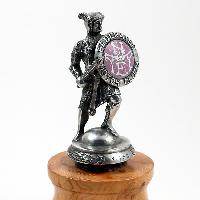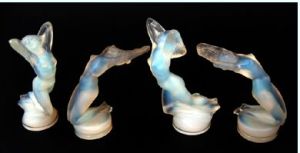Welcome to Mascot Mania
Manufacturer / Exporter / Supplier Of Guardian Knight Car Mascot, Glass Mascots, Motoring Badges, Motometers, Accessory Mascots
Welcome to Mascot Mania
Manufacturer / Exporter / Supplier Of Guardian Knight Car Mascot, Glass Mascots, Motoring Badges, Motometers, Accessory Mascots

An exceptionally rare and extremely fine 1921 North Eastern Automobile Association 'Guardian' car mascot, by Grant & Son of South Shields, British, numbered No 120, nickel bronze armoured figure in a winged helmet, holding a sword and a round shield in the form of a spoked wheel, showing the letters N.E.A.A. in purple and white enamel, (the only example that has ever appeared with this deluxe feature) and the words, ‘Federated Motor Clubs’.

Glass mascots are often placed in the same category as metal accessory mascots. They came in many shapes, styles and sizes from a number of designers, artists and sculptors. The name Rene Lalique is probably the one most people attribute to glass mascots. In 1925 he designed and produced the first glass car mascot for the French Citroen company. This mascot was used on their 5CV model and came in the form of five horses. He went on to design and produce a further 28 glass mascots. Today, pieces of original Lalique can command many thousands of poundsdollars. Rene Lalique was not alone in the field of glass mascot design, there were several companies producing glass mascots at around the same time. Some of the more familiar being: Red-Ashay, Great Britain; Warren-Kessler, Great Britain; Ernest Marius Sabino, Paris, and the Corning Glass Co., of New York.

The fitting of badges to motor vehicles goes back to the early 1900's. In 1897 Frederick Richard Simms, who is often referred to as the father of the British motor industry, founded the Automobile Club of Great Britain and Ireland. The Automobile Club soon started to attract some of the most influential people of the era. In 1907 Edward VII became its patron. Thereafter the club became known as The Royal Automobile Club, more commonly referred to by the initials RAC. In June 1905 another major British motoring club was formed, this was The Automobile Association. Like the RAC, it is also more commonly referred to by its initials. In March 1906 the AA produced the very first motoring club badge. Earliest examples carried an impressed signature of the club's first secretary, Stenson Cooke. A little later, the badges also featured the word secretary. Vehicle badges are not restricted to motoring clubs. They can, and often do, represent a wide range of hobbies and interests. The car badge is the longest living vehicle accessory, and many badges are still produced today. The badges shown on this site are a selection of many different examples, found in many different countries from all around the world. Many are shown in the condition they were found, and some would benefit from restoration.

Accessory mascots were not generally approved by a manufacturer and were often fitted to vehicles that did not have a factory fitted mascot. Sometimes owners would replace a factory mascot with an accessory mascot more befitting to their own personality. Also, as motometers were gradually replaced with in-car temperature gauges accessory mascots were often fitted to the radiator cap in their place. It is fair to say that accessory mascots were often made from better materials than factory mascots. Many accessory mascots were a straight copy of a manufacturers own design, an example of this is the beautiful 1933-1935 Buick goddess. Sometimes the copy was of a higher quality than the manufacturers original! Accessory mascots were produced to cover a wide range of interests and hobbies. A horses head mascot, for example, may have indicated the owner's interest in horses. A running fox may indicate an interest in hunting, Etc. However, this was not always the case. Many accessory mascots really had no bearing on any subject and were used simple to add that bit of style to a vehicle, perhaps giving it a sense of speed. In fact there are many speed nymph accessory mascots which were designed for this very purpose. Many companies made recognized vehicle accessory mascots, these can be seen in their literature and brochures. However, many of the so-called car mascots were in fact ornaments firstly fitted to ashtrays, clocks, trophies and some were even flagpole toppers!

Radiator-cap mounted engine temperature gauges bridge a time period between plain utilitarian radiator caps, and cap-mounted mascots. In the early years there was no way to tell the engine temperature unless the driver saw steam coming from the radiator cap! There was a need to know the temperature of the engine cooling system. The systems were very crude by today's standards and very susceptible to overheating. The first cooling systems were not pressurized, and the coolant had a low boiling point. To monitor the temperature, a simple device was invented which would display the engine temperature to the driver. It was very important to maintain the most efficient operating temperature, preventing engine destruction should it overheat. These devices took different approaches, from complicated gear type indicators using a bi-metallic device manufactured by Wilmot-Breeden in England, to the simple thermometer commonly referred to as the motormeter. Probably the best-known manufacturer was Boyce in the United States. Their factory was located in Long Island City, New York, and their device was known as the Boyce Motometer. Some companies copied the device, which resulted in patent infringement battles being fought over their manufacture.
Share your thoughts with other customers for Mascot Mania
Add Review